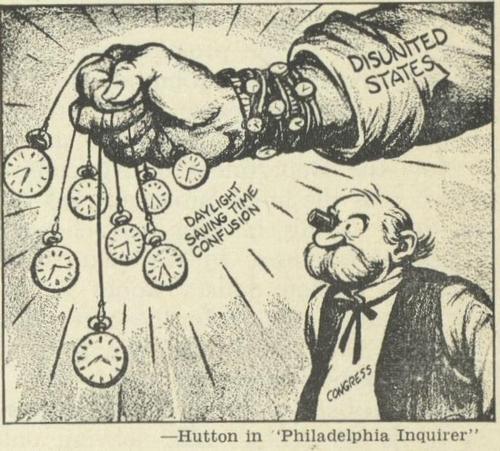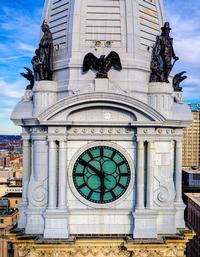A History Minute: 13 Things You Didn't Know About Daylight Saving Time
By Sally F.It's that time of year again, where we "Fall back" and set our clocks back an hour as Daylight Saving Time ends on Sunday, November 4, at 2:00 a.m. Although we gain an hour of sleep, we lose those precious longer lit days and instead have to wake up in the dark and see the sun set early in the evening. So, why do we do this? Read the following 13 anecdotes to learn more about Daylight Saving Time.
- Ben Franklin did not invent Daylight Saving Time
He did however publish calculations showing the financial benefits of rising with the sun and retiring early, thus saving candles. He published these calculations in 1784 as part of an essay poking fun at the French (and himself) for staying up most of the night playing cards or chess and sleeping until noon. His calculations showed that the French could save $200 million in today’s dollars by rising at dawn. Franklin proposed several measures to encourage this behavior, including a tax on shutters, rationing of candles, and the ringing of church bells and firing of cannon at sunrise. He did not propose changing clocks as it was the sun that was the common timekeeper in that era.
- Standard Time was not legislated in the U.S. until 1883
Before then, people set their clocks by looking at the sun and time varied between towns. When the railroads were built they needed predictable times to schedule the trains. By the 1880’s, the railroads had so much power they were able to pass legislation dividing the world into 24 time zones. The time zones start at Greenwich Meridian Time, which was first established in 1675 to serve naval navigation.
- Daylight Saving Time was first envisioned in 1907 by William Willett
Willett, a builder in Kent, England, proposed setting clocks forward by 20 minutes on 4 Sundays in April and back by 20 minutes on 4 Sundays in September. He was convinced this would improve health and happiness and save the country 2.5 million pounds (£). Parliament considered a Daylight Saving Bill in 1909 but voted it down. Willett did not live to see Daylight Saving Time become reality.
- Germany was the first country to establish Daylight Saving Time
It was legislated in 1916 to conserve electricity for the war. Great Britain soon did the same. Then in March, 1918, the U.S. Congress passed its first Daylight Saving law. It didn’t last long. Congress repealed daylight saving time on August 20, 1919, largely in response to pressure from the farm lobby. President Roosevelt instituted year-round daylight saving time from February, 1941 until September, 1945 to save energy for war use. President Nixon began daylight saving time 3 months early in 1974 and 1 month early in 1975 to conserve energy during the gasoline shortage.
- For much of the 20th century, U.S. municipalities made their own rules regarding Daylight Saving Time (thanks to the Supreme Court)
 When Massachusetts implemented daylight saving time in 1920, farmers represented by the Massachusetts State Grange went to court to stop the time change. In 1925, the case reached the Supreme Court. Justice Oliver Wendell Holmes wrote the majority opinion to uphold the Massachusetts law. From then until the Uniform Time Act of 1966, time chaos reigned for half of the year. 18 states observed Daylight Saving Time for 6 months, 18 for 4 or 5 months, and 12 states stayed on Standard Time. But within those states, cities and counties made their own rules. In St. Paul, Minnesota, there was an office building with 9 floors of city employees working on Daylight Saving Time and 9 floors of county employees working on Standard Time. On a 35-mile bus route from Moundsville, West Virgina to Steubenville, Ohio passengers had to reset their watches 7 times.
When Massachusetts implemented daylight saving time in 1920, farmers represented by the Massachusetts State Grange went to court to stop the time change. In 1925, the case reached the Supreme Court. Justice Oliver Wendell Holmes wrote the majority opinion to uphold the Massachusetts law. From then until the Uniform Time Act of 1966, time chaos reigned for half of the year. 18 states observed Daylight Saving Time for 6 months, 18 for 4 or 5 months, and 12 states stayed on Standard Time. But within those states, cities and counties made their own rules. In St. Paul, Minnesota, there was an office building with 9 floors of city employees working on Daylight Saving Time and 9 floors of county employees working on Standard Time. On a 35-mile bus route from Moundsville, West Virgina to Steubenville, Ohio passengers had to reset their watches 7 times.
- The Uniform Time Act is not uniform
States and territories may choose to remain on Standard Time year round. Hawaii and Arizona are always on Standard Time. Except for the Navajo Nation within Arizona, which observes Daylight Saving Time or the Hopi Nation within the Navajo Nation also within Arizona, which remains on Standard Time. Some Amish communities do not recognize Daylight Saving Time as well. Indiana did not adopt Daylight Saving Time until 2006.
- The Amtrak dilemma
In the fall overnight, trains must stop at the next station after the change and wait an hour before leaving. In the spring, overnight trains instantly become an hour late when the time changes and they must try to make up the time by increasing speed and shortening time at stops.
- Daylight Saving Time may cost us money rather than saving it
When Franklin did his original calculations, the savings was a result of using less lighting. This may have made sense for the first half of the 20th century, but with the advent of home air conditioning the situation has reversed. More daylight after work increases air conditioning use and air conditioning uses far more energy than lighting.
- Florida has adopted Daylight Saving Time year-round
They are the only state to do so, however the law cannot take effect until it is approved by the US Congress. The Uniform Time Act allows states an exemption for daylight saving time but not for standard time. Senator Marco Rubio introduced a bill in Congress to approve this change, which could cause some problems for the Sunshine State. For half the year, prime time television would start an hour later and when sports teams play on the west coast, games would start as late at 11:30 p.m. in Florida.
- Other states are considering the elimination of time changes
California’s Proposition 7 will allow voters to weigh in this November. If approved, the proposition allows the state legislature to consider the issue. Oklahoma has a bill in the legislature and Maine, Massachusetts, New Hampshire, and Rhode Island are all thinking about eliminated time chages as well. Idaho has considered two bills: one to move to permanent Standard Time and one to move to permanent Daylight Saving Time.
- The Pros and Cons of permanent Daylight Saving Time
Studies show reduced crime rates under Daylight Saving and increased participation in after-school sports and other outdoor recreation. Opponents cite the danger to children waiting for school buses on dark mornings and the difficulty of farmers managing cows and crops that follow the sun, not the clock.
- The U.S. is not the only one with time change issues
Britain established continuous Summer Time in 1968, but returned to clock changing in 1972 due to a significant increase in early morning traffic deaths, particularly in the north and Scotland. This year the European Commission will recommend that the EU eliminate the semi-annual clock change and adopt "summertime" year round. In Queensland, Australia there is a political party devoted to the cause of Daylight Saving Time.
- Russian clocks were set an hour ahead of the rest of the world for 61 years
In the spring of 1930, Stalin ordered all clocks in the Soviet Union be changed to Daylight Saving Time, but in October he forgot to order them to fall back. After that, Russians continued to move clocks ahead every spring and back every fall perpetuating the error. In 1991, officials corrected the mistake by telling citizens not to advance their clocks. But several regions moved their clocks ahead anyway and others moved them back an hour. In 2014, Russia went on permanent standard time.
Additional Resources
Videos
Read

Have a question for Free Library staff? Please submit it to our Ask a Librarian page and receive a response within two business days.


